Reagan came along at a time when I was otherwise engaged, so his tenure passed without much awareness on my part. That’s one version of the story. The other is that I just couldn’t stand to listen to the guy. If he came on television, I found myself leaving the room. My response to him was visceral. I felt "conned," and I suppose I went on strike. So all of this looking up about Reagan is really new information for me. This article a few months back is what got me thinking about him.
There’s plenty of blame to go around these days. But the prime villains behind the mess we’re in were Reagan and his circle of advisers — men who forgot the lessons of America’s last great financial crisis, and condemned the rest of us to repeat it.
“This bill is the most important legislation for financial institutions in the last 50 years. It provides a long-term solution for troubled thrift institutions. … All in all, I think we hit the jackpot.” So declared Ronald Reagan in 1982, as he signed the Garn-St. Germain Depository Institutions Act. He was, as it happened, wrong about solving the problems of the thrifts. On the contrary, the bill turned the modest-sized troubles of savings-and-loan institutions into an utter catastrophe. But he was right about the legislation’s significance. And as for that jackpot — well, it finally came more than 25 years later, in the form of the worst economic crisis since the Great Depression. For the more one looks into the origins of the current disaster, the clearer it becomes that the key wrong turn — the turn that made crisis inevitable — took place in the early 1980s, during the Reagan years.
Attacks on Reaganomics usually focus on rising inequality and fiscal irresponsibility. Indeed, Reagan ushered in an era in which a small minority grew vastly rich, while working families saw only meager gains. He also broke with longstanding rules of fiscal prudence. On the latter point: traditionally, the U.S. government ran significant budget deficits only in times of war or economic emergency. Federal debt as a percentage of G.D.P. fell steadily from the end of World War II until 1980. But indebtedness began rising under Reagan; it fell again in the Clinton years, but resumed its rise under the Bush administration, leaving us ill prepared for the emergency now upon us.
The increase in public debt was, however, dwarfed by the rise in private debt, made possible by financial deregulation. The change in America’s financial rules was Reagan’s biggest legacy. And it’s the gift that keeps on taking. The immediate effect of Garn-St. Germain, as I said, was to turn the thrifts from a problem into a catastrophe. The S.& L. crisis has been written out of the Reagan hagiography, but the fact is that deregulation in effect gave the industry — whose deposits were federally insured — a license to gamble with taxpayers’ money, at best, or simply to loot it, at worst. By the time the government closed the books on the affair, taxpayers had lost $130 billion, back when that was a lot of money.
But there was also a longer-term effect. Reagan-era legislative changes essentially ended New Deal restrictions on mortgage lending — restrictions that, in particular, limited the ability of families to buy homes without putting a significant amount of money down. These restrictions were put in place in the 1930s by political leaders who had just experienced a terrible financial crisis, and were trying to prevent another. But by 1980 the memory of the Depression had faded. Government, declared Reagan, is the problem, not the solution; the magic of the marketplace must be set free. And so the precautionary rules were scrapped…
… it was the explosion of debt over the previous quarter-century that made the U.S. economy so vulnerable. Overstretched borrowers were bound to start defaulting in large numbers once the housing bubble burst and unemployment began to rise. These defaults in turn wreaked havoc with a financial system that — also mainly thanks to Reagan-era deregulation — took on too much risk with too little capital. There’s plenty of blame to go around these days. But the prime villains behind the mess we’re in were Reagan and his circle of advisers — men who forgot the lessons of America’s last great financial crisis, and condemned the rest of us to repeat it.
The forces that produced a Ronald Reagan Presidency were not all misguided. Our tax structure still carried a desperate taint from the Great Depression and World War II. Perhaps the Banking and Market regulations were a little too tight. Maybe we had leaned a little too far into some of our entitlement programs. And government was obviously eating up an increasing piece of the pie. So when the the pendulum swung to the right, it seemed like it was their turn.
Carl Jung hypothesized that we have something he called a Collective Unconscious – an ancient piece of mental life that we all share. He was trying to explain why our myths and even our individual psychologies are so similar over time, even across cultures that aren’t in contact. Most of us don’t believe that, but his observation of similarity and historical influence are valid. There are often forces at work that are unseen, rooted in a history almost forgotten, and there is a big piece of that in this story. Krugman talks about "men who forgot the lessons of America’s last great financial crisis, and condemned the rest of us to repeat it," assuming that everyone learned the same thing during the Great Depression. But there were people who saw FDR’s programs as anything but salvation. They never forgot the lessons they had learned. They saw someone who punished them for being wealthy by taxing them to the hilt and who made it really hard for them to be the entrepreneurs they wanted to be or "play the market" like they used to. To them, FDR was the Great Satan, the enemy of a beloved version of Capitalism. To them, FDR was opposed to freedom itself.
Krugman leaves out a big piece of Reaganism – the military spending. There were others who saw the lead-up to World War II through other glasses – appeasement gone awry. If we’d kicked Hilter’s ass earlier, they thought, we could’ve stopped him cold. Also, all that money we spent during the war went somewhere – a lot into the pockets of the Military Industrial Complex. We called them the Hawks, those people who personified another inhabitant of mankind’s Collective Unconscious – the Will to Power. Their lesson from World War II was that military might is what matters in International Affairs.
The disenfranchised entrepreneurs, the heavily taxed, and the hawks among us were joined by the anti-Communists and the Federalist elitists. In the wake of FDR’s New Deal, they formed clubs – the American Enterprise Institute, the Family, the Hudson Institute, the Hoover Institute, the Committee for the Clear and Present Danger, the John Birch Society, etc. And for all of them, FDR persisted as a symbol for the other side of their coin. They tried to emerge with Goldwater, but ascendancy eluded them until the voice of G.E., a veteran of the red-baiting Hollywood years, finally gave them their unlikely winning ticket.
 I was being tongue-in-cheek earlier when I used Jung’s Collective Unconscious as a symbol for the anti-FDR sentiment that lay in wait for decades or the recurrent power dynamics that haunt human history – but I’m dead serious about this next Jung analogy. Jung conceived of a populated mind, filled with internal characters in discord. And one archetype he felt we collectively inherited he called the wise old man. Certainly the figure of the tribal elder, the statesman, the aged Einstein, the bearded philosopher, the old king runs like a river through all of history, culture, and literature. For Jung, however, this was not a good archetype. It was the know-it-all part of our personality to be conquered, not venerated. Modern theorists see what Jung personified as a wise old man as our narcissism – that pesky belief that things we think are right. But, no matter how you see it, we look to our elders for guidance in times of trouble. It’s just what we do, what we’ve always done. And Ronald Reagan gave us an Oscar winning performance as the wise old man. He had the confidence of a Narcissist – he just knew he was right.
I was being tongue-in-cheek earlier when I used Jung’s Collective Unconscious as a symbol for the anti-FDR sentiment that lay in wait for decades or the recurrent power dynamics that haunt human history – but I’m dead serious about this next Jung analogy. Jung conceived of a populated mind, filled with internal characters in discord. And one archetype he felt we collectively inherited he called the wise old man. Certainly the figure of the tribal elder, the statesman, the aged Einstein, the bearded philosopher, the old king runs like a river through all of history, culture, and literature. For Jung, however, this was not a good archetype. It was the know-it-all part of our personality to be conquered, not venerated. Modern theorists see what Jung personified as a wise old man as our narcissism – that pesky belief that things we think are right. But, no matter how you see it, we look to our elders for guidance in times of trouble. It’s just what we do, what we’ve always done. And Ronald Reagan gave us an Oscar winning performance as the wise old man. He had the confidence of a Narcissist – he just knew he was right.

But what he did wasn’t wise at all. He turned the fantasies of the now ancient anti-FDR societies into realities – a massive tax cut for the rich, undoing the banking restrictions, deregulating the markets, cutting social programs, and feeding the Military Industrial Complex like it had never been fed before in peacetime. While preaching a gospel of fiscal responsibility, as Krugman points out, he ran up the debt like a mental patient with a credit card having a manic episode. He returned us to the ancient wisdom of Calvin Coolidge, his boyhood idol, and raled at the communists as he had done as a Hollywood actor. If he had an archetype himself, it was the good cowboys in his Grade B westerns, cleaning up the misbegotten frontier town. And he left us a legacy of wise old men in training like Cheney, Rumsfeld, Wolfowitz, Bolton, and the neoconservatives who lay in wait through the Clinton years to give us another more virulent round – hiding behind the most unwise kids on the block – George W. Bush and Karl Rove [whose only claim to fame was to figure out how to capture the Christian Right in their web].
There’s a lesson in all of this. We liberals have been dormant for decades now. It’s been a long time since John Kennedy, Lyndon Johnson, the Civil Rights Legislation, Voting Rights, Medicare, the "Great Society. We’ve watched many of our gains from those days go by the wayside. I’m getting into the old man period myself, and I can feel those hopes from my youth rising with the possibilities opened up by the 2008 elections [I hate to reveal this, but I think my thoughts are right too]. And I can feel the impatience of the latter day version of my kind of people – the Progressives – biting at the bit for radical social change. But we can also make the same mistake the Reaganites made – getting carried away with the resentments and the dreams from a bygone time. Revenge of the Doves is no better than Revenge of the Hawks.
But Krugman is correct – Reagan did do it. And the Bushes and Cheney that followed made it worse. The problems they addressed were real problems – the size of government, how we finance our government, how we both regulate and encourage our economy, our energy needs, our foreign policy and relationship with the planet’s pugalists. In our young country, it seems like we’re always getting over something – slavery, the Civil War, the Great War, Prohibition, the Depression, World War II, the New Deal, the Cold War, the sixties, Reagan, 911, and now Bush/Cheney. The lesson here is that two powerful archetypal wise old men, Ronald Reagan and later Dick Cheney, turned out to be so caught up in the anachronistic struggles from their own past lives that they created many more problems than they solved. The modern challenge is to avoid repeating their misguided search for solutions in some idealized past.
I suppose our veneration of wise old men might represent some remnant of childhood when we turned to our parents in confusing times. In truth, the wisdom of some elderly people is a reflective wisdom, disconnected from the passions of moment, a humility born in learning from personal error. Neither of these men had anything close to that…


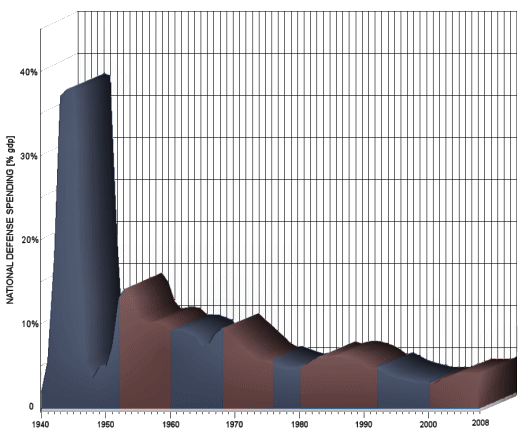
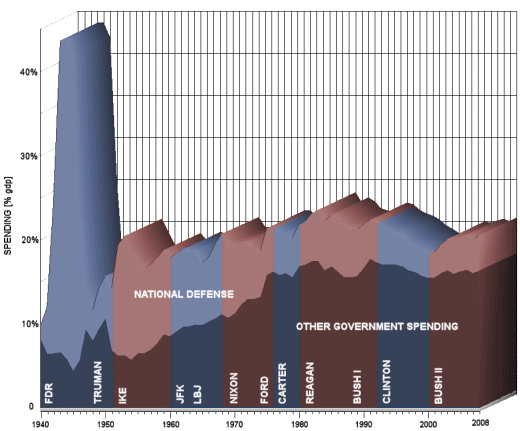



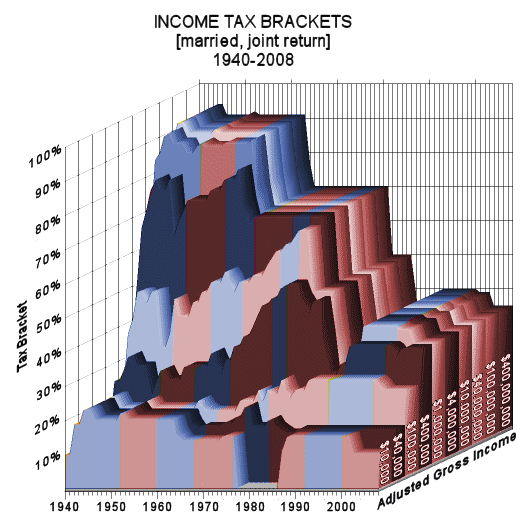
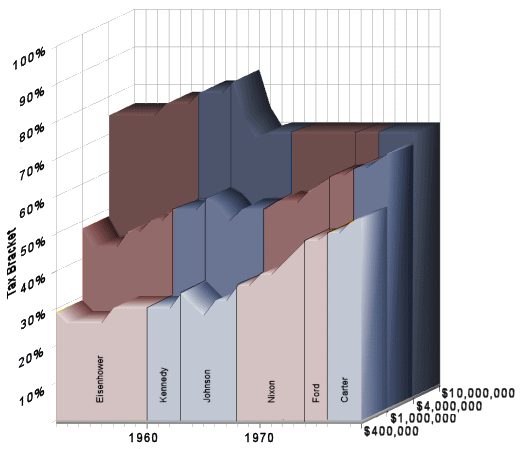
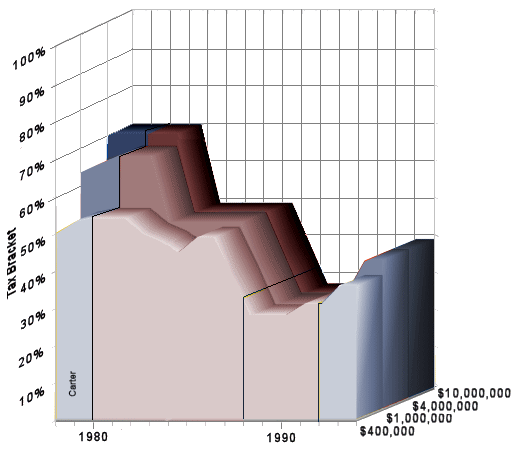
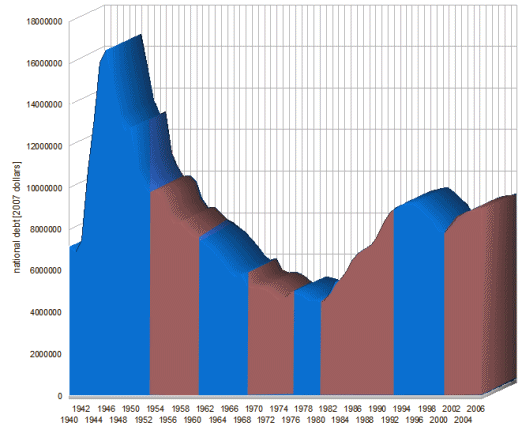
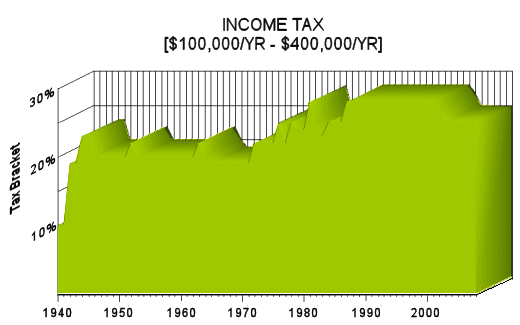
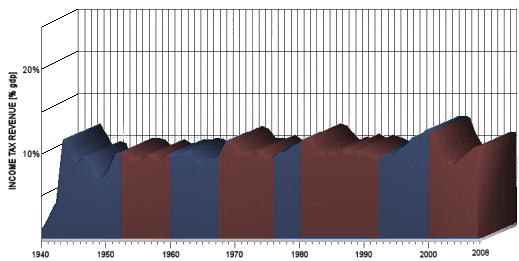
 I was being tongue-in-cheek earlier when I used Jung’s Collective Unconscious as a symbol for the anti-FDR sentiment that lay in wait for decades or the recurrent power dynamics that haunt human history – but I’m dead serious about this next Jung analogy. Jung conceived of a populated mind, filled with internal characters in discord. And one archetype he felt we collectively inherited he called the wise old man. Certainly the figure of the tribal elder, the statesman, the aged Einstein, the bearded philosopher, the old king runs like a river through all of history, culture, and literature. For Jung, however, this was not a good archetype. It was the know-it-all part of our personality to be conquered, not venerated. Modern theorists see what Jung personified as a wise old man as our narcissism – that pesky belief that things we think are right. But, no matter how you see it, we look to our elders for guidance in times of trouble. It’s just what we do, what we’ve always done. And Ronald Reagan gave us an Oscar winning performance as the wise old man. He had the confidence of a Narcissist – he just knew he was right.
I was being tongue-in-cheek earlier when I used Jung’s Collective Unconscious as a symbol for the anti-FDR sentiment that lay in wait for decades or the recurrent power dynamics that haunt human history – but I’m dead serious about this next Jung analogy. Jung conceived of a populated mind, filled with internal characters in discord. And one archetype he felt we collectively inherited he called the wise old man. Certainly the figure of the tribal elder, the statesman, the aged Einstein, the bearded philosopher, the old king runs like a river through all of history, culture, and literature. For Jung, however, this was not a good archetype. It was the know-it-all part of our personality to be conquered, not venerated. Modern theorists see what Jung personified as a wise old man as our narcissism – that pesky belief that things we think are right. But, no matter how you see it, we look to our elders for guidance in times of trouble. It’s just what we do, what we’ve always done. And Ronald Reagan gave us an Oscar winning performance as the wise old man. He had the confidence of a Narcissist – he just knew he was right.
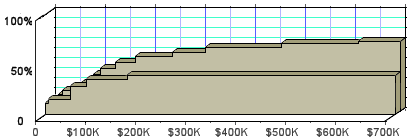
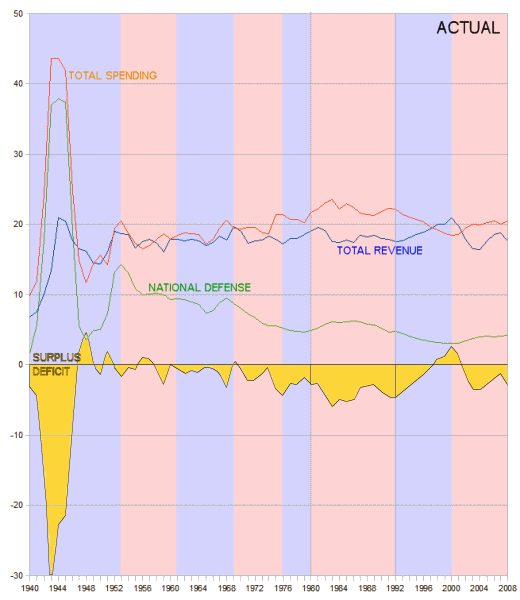
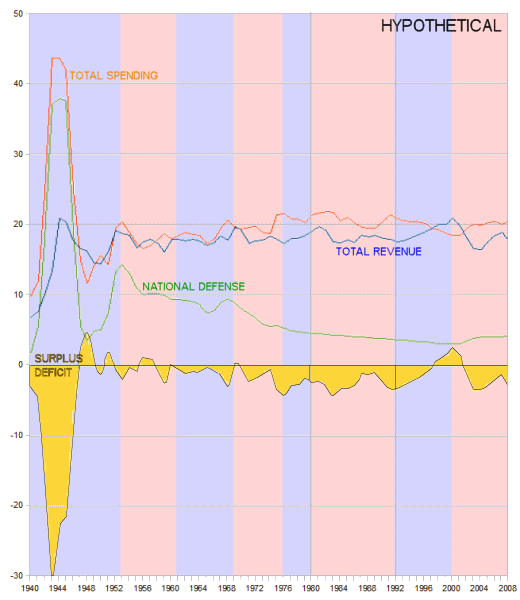
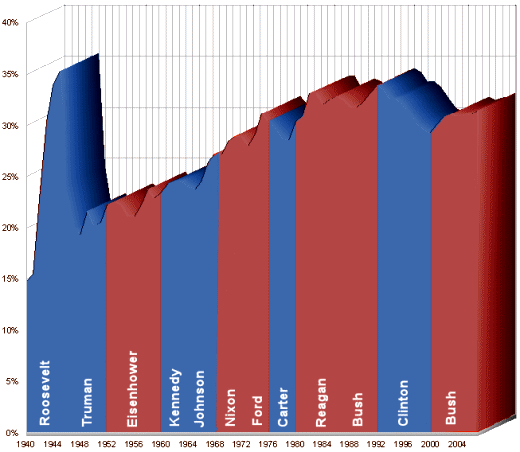
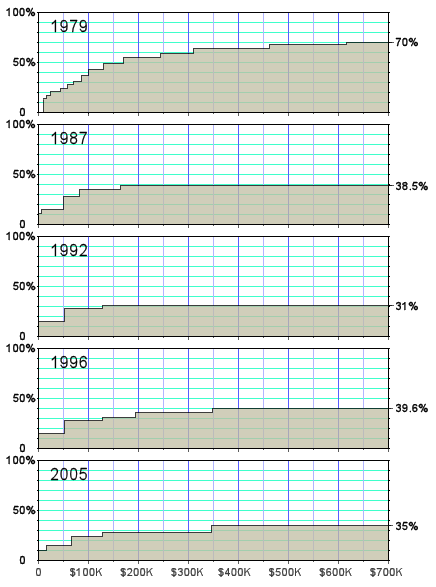
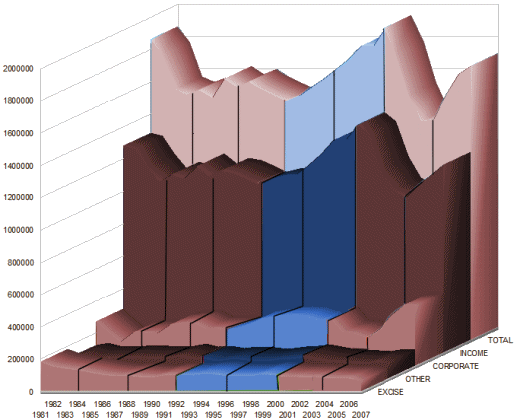
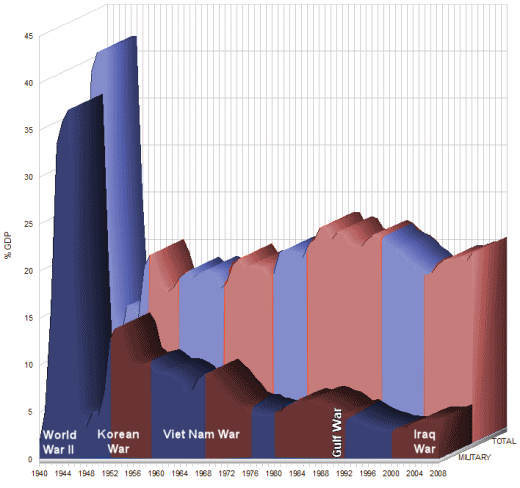
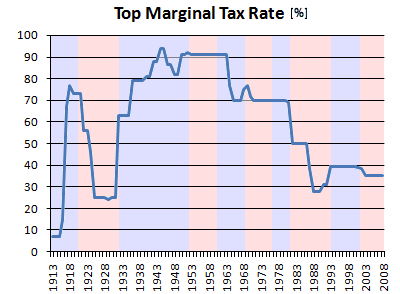
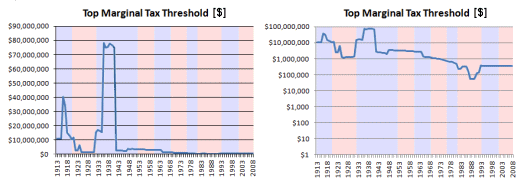


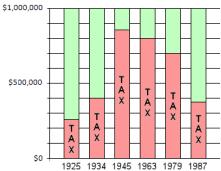 In 1963, some 20 years after the end of the war, our hypothetical rich guy making $1,000,000 a year [adjusted gross income in 2008 dollars] was still paying $800,000/year in taxes. Johnson lowered the taxes brackets in 1964, but he continued to pay $700,000/year in 1979. When Reagan was elected, he instituted two deep tax cuts that radically changed things for Mr. Hypothetical. By 1987, he was paying $385,000/year on his $1,000,000 [adjusted gross income in 2008 dollars]. I realize this is hard to follow on the graphs because of the scale differences, so the graph on the right summarizes the changes in taxation for our hypothetical rich guy over the years.
In 1963, some 20 years after the end of the war, our hypothetical rich guy making $1,000,000 a year [adjusted gross income in 2008 dollars] was still paying $800,000/year in taxes. Johnson lowered the taxes brackets in 1964, but he continued to pay $700,000/year in 1979. When Reagan was elected, he instituted two deep tax cuts that radically changed things for Mr. Hypothetical. By 1987, he was paying $385,000/year on his $1,000,000 [adjusted gross income in 2008 dollars]. I realize this is hard to follow on the graphs because of the scale differences, so the graph on the right summarizes the changes in taxation for our hypothetical rich guy over the years.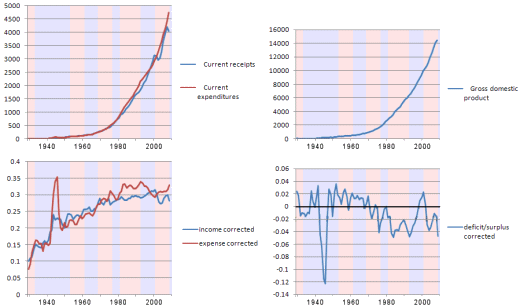
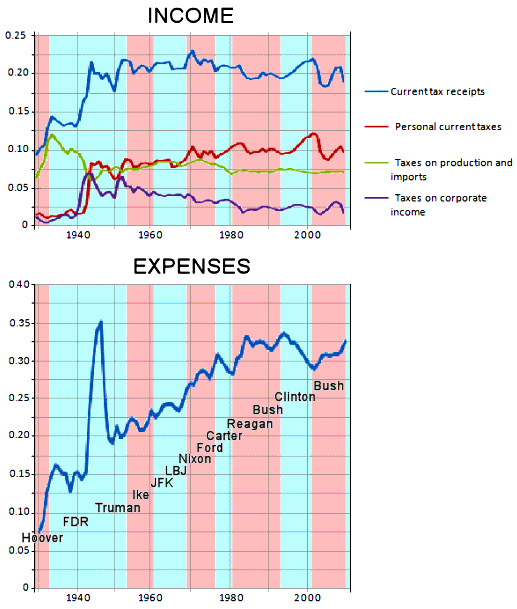
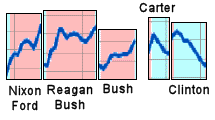
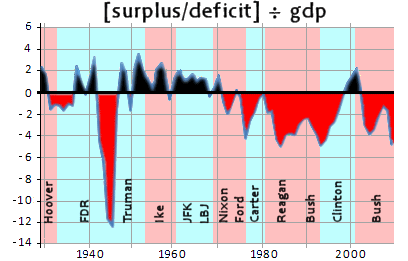
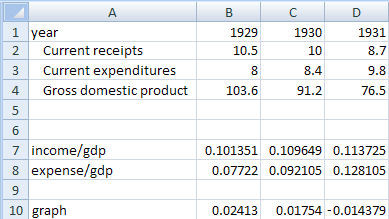 I’ve gotten a couple of comments about my obsession with graphs ["They’re too hard to figure out."]. So I’m going to narrate this one, because it’s important as it sits in opposition to the biggest Republican lie of all. The data comes from the Treasury Department and the Bureau of Economic Analysis. line 2 and line 3 are the country’s income and expenses by year. line 4 is the Gross Domestic Product [used to correct for inflation]. The corrected values are shown as a percent of the GDP. line 10 is line 7 minus line 8, the deficit or surplus for the year.
I’ve gotten a couple of comments about my obsession with graphs ["They’re too hard to figure out."]. So I’m going to narrate this one, because it’s important as it sits in opposition to the biggest Republican lie of all. The data comes from the Treasury Department and the Bureau of Economic Analysis. line 2 and line 3 are the country’s income and expenses by year. line 4 is the Gross Domestic Product [used to correct for inflation]. The corrected values are shown as a percent of the GDP. line 10 is line 7 minus line 8, the deficit or surplus for the year.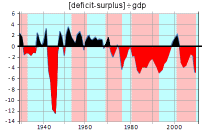 The inset on the left is a colored in version of the graph – in the red and in the black. So in the early years of the graph, both Hoover and FDR used deficit spending to combat the Depression. Then there was the massive debt from World War II. The modern deficit spending started with Nixon and Ford. In 1976, Carter‘s Administration reversed the trend, but never made it into the range of surplus. The routine deficit spending started with Reagan and GHW Bush. Again, Clinton‘s Administration reversed the trend. It took into his second term to balance the budget and begin to pay back our debt. GWBush [Cheney] immediately returned us to deficit spending, persisting throughout that Administration and exiting with a real bang with their Bank Bailout.
The inset on the left is a colored in version of the graph – in the red and in the black. So in the early years of the graph, both Hoover and FDR used deficit spending to combat the Depression. Then there was the massive debt from World War II. The modern deficit spending started with Nixon and Ford. In 1976, Carter‘s Administration reversed the trend, but never made it into the range of surplus. The routine deficit spending started with Reagan and GHW Bush. Again, Clinton‘s Administration reversed the trend. It took into his second term to balance the budget and begin to pay back our debt. GWBush [Cheney] immediately returned us to deficit spending, persisting throughout that Administration and exiting with a real bang with their Bank Bailout.